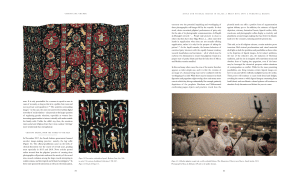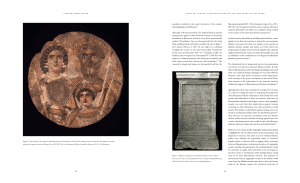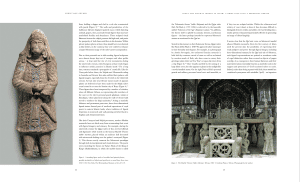Working to improve mutual understanding between the Middle East and the West
Working to improve mutual understanding between the Middle East and the West
No products in the basket.
£60.00
The images released by The Islamic State of militants smashing statues at ancient sites were a horrifying aspect of their advance across Northern Iraq and Syria during 2015-16. Their leaders justified this act of iconoclasm by arguing that such actions were divinely decreed in Islam, a notion that has remained fixed in the public consciousness.
The Image Debate is a collection of thirteen essays that examine the controversy surrounding the use of images in Islamic and other religious cultures and seek to redress some of the misunderstandings that have arisen.
Written by leading academics from the United States, Australia, Turkey, Israel and the United Kingdom, the book opens with an introduction by the editor Christiane Gruber, who sets the subject in context with a detailed examination of the debates over idols and the production of figural images in Islamic traditions.
The book is divided into three sections: the first deals with pre-modern Islamic practices and anxieties concerned with image-making; the second addresses similar issues in Judaism, in Christianity during the Byzantine period, in pre-Islamic Iran and Central Asia, and in Hindu and Buddhist contexts in South Asia; and the third brings the reader back to Islamic lands by examining traditions of figural representation in the modern and contemporary periods.
Christiane Gruber is Professor of Islamic Art at the University of Michigan, Ann Arbor. Her primary fields of research include Islamic book art, figural painting and depictions of the Prophet Muhammad.
Contributors: Shiva Balaghi, James Bennett, Robert DeCaroli, Christiane Gruber, Steven Fine, Finbarr Barry Flood, Rose Issa, Mika Natif, Oya Pancaroğlu, Allen F. Roberts, Mary Nooter Roberts, Yousuf Saeed, Michael Shenkar, Alicia Walker.
| Theme | Art, Religion & Philosophy, Visual Art |
|---|
Stefano Carboni – Foreword
Christiane Gruber – Idols and Figural Images in Islam: A Brief Dive into a Perennial Debate
Part 1: Pre-Modern Islam
Mika Natif – ‘Painters Will Be Punished’: The Politics of Figural Representation
Amongst the Umayyads
Finbarr Barry Flood – Signs of Silence: Epigraphic Erasure and the Image of the Word
Oya Pancaroğlu – Conditions of Love and Conventions of Representation in the Illustrated
Manuscript of Varqa and Gulshah
Part 2: Beyond the Islamic world
Alicia Walker – Iconomachy in Byzantium
Steven Fine – The Image in Jewish Art
Michael Shenkar – Religious Imagery and Image-Making in pre-Islamic Iran and Central Asia
Robert Decaroli – Conspicuous Absences: The Avoidance and Use of Images in Early South Asian Art
Part 3: Modern and Contemporary Islam
Yousuf Saeed – The Figural Image in Islamic Devotional Art of the Indian Subcontinent
James Bennett – The Shadow Puppet: A South-East Asian Islamic Aesthetic
Allen F. Roberts and Mary Nooter Roberts – Enigma and Purpose: Visual Hagiographies of Urban Senegal
Rose Issa – Figures of Protest in Contemporary Arab and Iranian Art
Shiva Balaghi – Only for My Shadow: Figuration in Contemporary Iranian Art
Foreword
In the early years of the second Islamic millennium, Qadi Ahmad ibn Mir Munshi al-Husayni compiled his treatise on calligraphers and painters (circa 1005/1596–97). The text contains the well-known sentence: ‘the qalam is of two kinds … one vegetable … the other animal. The latter is a brush made of hair and, by its means, wizards of art, similar in intelligence to Mani, and Chinese and Frankish magicians … have become masters in the workshop of Destiny and Fate.’ Qadi Ahmad goes on to state that ‘… the wonderful phantasy and strange native force (angīza) of the artists are known in all countries and witnessed by men possessed of sight. … The image which the portrait-painter reveals on the tablets of the mind cannot be reflected in everybody’s mirror of beauty.’1
Just a few years earlier, Cesare Ripa Perugino (circa 1560–1625) finished his very influential Iconologia overo descrittione dell’imagini universali cavate dall’antichità et da altri luoghi (first published in 1593). Among the ‘moral emblems’ expressed in the images of his Iconologia, Ripa characterized Pittura (‘Painting’), as a ‘Donna bella, co’ capelli negri, & grossi sparsi, & ritorti in diverse maniere, con le ciglia inarcate, che mostrino pensieri fantastichi; si cuopre la bocca, con una fascia legata dietro à gli orecchi, con una catena d’oro al collo, dalla quale penda una maschera, & habbia scritto nella fronte, imitatio.’ (‘A beautiful woman with thick and curly black hair, and arched eyebrows demonstrating fanciful thoughts; her mouth is covered by a strap tied behind her ears; a gold chain is around her neck with a mask hanging from it, onto which the word imitation is engraved’).2 In the text, Ripa explains that Painting is a noble exercise which cannot be achieved successfully without much use of intellect. As for the image, the mouth is covered because the act of painting is performed in silence and solitude; the mask, being the portrait of a human face, symbolizes that imitation is inextricably conjoined to Painting.
At almost the same time that Qadi Ahmad and Cesare Ripa were writing in the sixteenth century, a puppet’s maker of wayang kulit brought his image to life by ‘breaking open’ its eyes, mouth and nose (as explained by James Bennett in his essay, pp.176–78). This practice was reminiscent of earlier South Asian, Hindu–Buddhist rituals during which temple images were consecrated by symbolically ‘opening the eyes’.
In Iran, Italy and Java in the sixteenth century – as well as in the different cultures, geographical regions and chronologies addressed in the present diverse compilation of essays – the Image is seen as an imitatio that can be infused with life by its creator through a magical and/or symbolic gesture (or sometimes with a gesture of the mind). Whether this gesture will eventually plunge the artists into the circles of hell, or celebrate them during life as noble intellectuals, the Image Debate represents one of the most fascinating trans-cultural, transnational, trans-religious arguments and philosophical conversations that can take place today in comparative studies in academic circles.
The impetus for this publication stemmed initially from my desire to conceive and organize an exhibition entitled The Image of Islamic Art in response to one of the most common misconceptions surrounding the art of the Islamic world related to the admissibility and practice of the representation of human and other living beings throughout its art historical development. This topic, which is often mentioned by both the informed and the misinformed, has never been addressed in a scholarly but accessible art historical context as a major exhibition. I see this as a project that speaks directly and in an approachable manner to Muslim and non-Muslim audiences and places the subject firmly within its academic and historical contexts.
The essays contained in this book provide a scholarly framework for the more comprehensive publication that was originally planned; this would have included catalogue entries and critical interpretations for approximately 150 works of art selected for the exhibition, together with introductory thematic essays. The exhibition project is intended to cover almost 1500 years of artistic developments in the Islamic world and will also include a section dedicated to post-9/11 works by contemporary artists that address current artistic, political and social issues concerning the place of Islamic culture in our society and the ongoing debate addressing freedom of speech versus respect for religious beliefs.
The vagaries of exhibition organization and the security risks, or perception thereof, associated with this subject have momentarily delayed the project, although it is still very much my hope that the exhibition will become a reality and that a book will be issued to accompany it as a complement to this volume. It is, however, with great pleasure that I welcome the publication of the ‘academic’ half of the project thanks to the energetic efforts of Christiane Gruber, of the whole team at the Gingko Library and of course all the authors. The Image Debate represents a timely and very significant contribution to a complex and stimulating field of studies and everyone involved should be warmly congratulated.
Stefano Carboni
Perth, December 2018
NOTES



‘Assembling an all-star cast of contributors, Christiane Gruber has put together an outstanding exploration of visual sensibilities in the history of Islam.[…] One after the other, chapters explore the political, philosophical, aesthetic, and devotional aspects of imaging to model how the study of religious visual culture should be done’
—Professor David Morgan, Duke University
‘The essays in this collection, sensitively edited by Christiane Gruber, examine the subject by covering an unusual span of creativity and reception, ranging from the pre-Islamic world to our emoticons […] This is a wide-ranging collection, asking some difficult questions. The essays and their very comprehensive bibliographies can take us in new directions…’
– Jane Jakeman, The Art Newspaper
‘This book can be highly recommended because of its diverse perspectives […] In her introductory inspirational contribution ‘Idols and Figural Images in Islam: A Brief Dive into a Perennial Debate’ Christiane Gruber gives a broad overview of the early Islamic ban on the worship of statues and natural stone setting understood as divine beings up to the ban on selfies at the Hajj ceremonies in Mecca by the Saudi religious authorities. She follows the legal debates as well as the political practice through the centuries and points above all to the different interpretations of the Koran on this topic.’
– Peter Heine, Orientalische Literaturzeitung
Our work relies on the generous support of our donors. Any contribution, no matter how small, helps us achieve our aims.